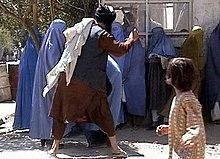Secret photography
This article needs additional citations for verification. (August 2009) |

Secret photography is the use of an image or video recording device to photograph or film a person who is unaware that they are being intentionally photographed or filmed. It is sometimes called covert photography.
Uses
[edit]A person may be unaware of being photographed in a variety of situations, such as:

- Fixed or mobile closed-circuit television surveillance in public and private areas.
- Stalking by photographers of celebrities.
- Use of a hidden camera in investigative journalism.
- During industrial espionage.
- During intelligence gathering by police or private investigators.
- During the investigation phase of workman's compensation claim adjudication.
- By vigilantes.
- By political protesters or activists.
- By academics such as ethnographic researchers or participant observer sociologists.
- As a prank, e.g. from a friend's mobile camera phone.
- By voyeurs for sexual or other purposes
It has been in use by British police since intelligence gathering on the suffragette movement in the 1900s.[1]
Some fine art photographers have displayed a fascination with the forms of secret voyeuristic photography. Voyeuristic photography has also been centrally explored in movies such as Powell & Pressburger's Peeping Tom, and Michelangelo Antonioni's Blowup, and has appeared to comic effect in films such as Gregory's Girl and American Pie.
Technology
[edit]Sometimes normal cameras are used, but the photographer is concealed. Sometimes the camera itself is disguised or concealed. Some obvious element of concealment (or great distance) is generally needed to make such photography fall under the category of "secret photography" rather than street photography or documentary photography.
Erich Salomon took images of European summit meetings and a session of the US Supreme Court in secret using an Ermanox camera hidden in his hat. Some classic early U.S. street photography – such as that of Paul Strand on the Lower East Side[2] – was obtained by fixing a second "dummy lens" to the camera, whereas the real shot was taken from the side. Although spy cameras small enough to fit inside a pocket watch had existed since the 1880s, since the 1950s advances in miniaturisation and electronics has greatly aided the ability to conceal miniature cameras, and the quality and affordability of tiny cameras (often called "spy cameras" or subminiature cameras) has now greatly increased. Some consumer compact digital cameras are now so small that in previous decades they would have qualified as "spy cameras", and digital cameras of 41 megapixels are now being embedded in some mobile camera phones. [citation needed] For larger cameras (DSLR or EVIL), right-angle mirror attachments are commercially available that, when mounted on long-focus lenses, can deceive the subject by producing the impression that the camera is pointed in a different direction.
Laws and ethics
[edit]There are various personal privacy laws in different countries, which impact the secret photography of individuals and the publication of any resulting pictures. France for instance, has very strict laws against publication of such images,[3] while the British tabloid press will publish a variety of secret photography. Examples in Britain include the publication of photos of Princess Diana secretly taken in a gym,[4] and the publication of secretly taken photos of Naomi Campbell, which led to a major court case.[5]
News gathering organisations and media trade unions issue ethical guidelines to their members on the use of secret and telephoto lens photography.[6]
See also
[edit]- Hidden camera
- Street photography
- Photojournalism
- Celebrity photography
- Surveillance
- Long focus lens
- Subminiature photography
- Candid photography
- Upskirt
References
[edit]- ^ "Spy pictures of suffragettes revealed" Archived 16 October 2007 at the Wayback Machine. BBC, 3 October 2003: For an in-depth British history see: Bunyan, Tony. The Political Police in Britain. Quartet Books, 1977.
- ^ Metropolitan Museum of Modern Art Archived 20 December 2017 at the Wayback Machine – "Strand set out for Five Points, the heart of the immigrant slums on the Lower East Side, with his camera rigged with a false lens to distract attention. Approaching a potential subject, Strand turned ninety degrees away and aimed the false lens in the direction he was facing. The real lens, on an extended bellows, stuck out under his arm toward the person ..."
- ^ "The notoriously strict privacy laws in France ensure that such intrusion into the private lives of public figures is rare" – The Daily Telegraph 28 August 2005 – this refers to the "Presumption of Innocence and Rights of Victims" (2001) law, prohibiting the publication of "any photograph of a person without their express consent". For an English account of the new law see: Tom Stoddart. "Out Of Love" in Black & White Photography Magazine, Aug/Sep 2001, pages 24–28.
- ^ "Diana sues over gym photos" Archived 21 May 2017 at the Wayback Machine. BBC 9 November 1993.
- ^ "Naomi Campbell v MGN Limited" – Mr Justice Morland, 27 March 2002 Archived 4 December 2004 at the Wayback Machine. Ms. Campbell was awarded damages and costs, but this was based on 'breach of confidence' and not the privacy infringent claim.
- ^ Mediawise archive of media 'codes of conduct' from around the world Archived 24 August 2005 at the Wayback Machine
Further reading
[edit]Covert Imagery, Peter Jenkins, ISBN 978 09535378 53, Intel Publishing 2015
